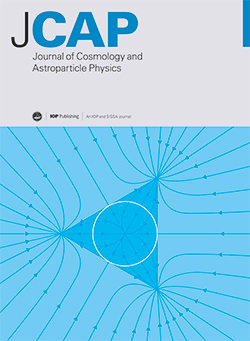Constraints on dark energy and modified gravity from the BOSS Full-Shape and DESI BAO data
IF 5.3
2区 物理与天体物理
Q1 ASTRONOMY & ASTROPHYSICS
Journal of Cosmology and Astroparticle Physics
Pub Date : 2025-03-19
DOI:10.1088/1475-7516/2025/03/036
引用次数: 0
Abstract
We constrain dark energy and modified gravity within the effective field theory of dark energy framework using the full-shape BOSS galaxy power spectrum, combined with Planck cosmic microwave background (CMB) data and recent baryon acoustic oscillations (BAO) measurements from DESI. Specifically, we focus on a varying braiding parameter αB, a running of the “effective” Planck mass αM, and a constant dark energy equation of state w. The analysis is performed with two of these parameters at a time, including all the other standard cosmological parameters and marginalizing over bias and nuisance parameters. The full-shape galaxy power spectrum is modeled using the effective field theory of large-scale structure up to 1-loop order in perturbation theory. We find that the CMB data is most sensitive to αB, and that adding large-scale structure information only slightly changes the parameter constraints. However, the large-scale structure data significantly improve the bounds on αM and w by a factor of two. This improvement is driven by background information contained in the BAO, which breaks the degeneracy with H0 in the CMB. We confirm this by comparing the BOSS full-shape information with BOSS BAO, finding no significant differences. This is likely to change with future high-precision full-shape data from Euclid and DESI however, to which the pipeline developed here is immediately applicable.求助全文
约1分钟内获得全文
求助全文
来源期刊

Journal of Cosmology and Astroparticle Physics
地学天文-天文与天体物理
CiteScore
10.20
自引率
23.40%
发文量
632
审稿时长
1 months
期刊介绍:
Journal of Cosmology and Astroparticle Physics (JCAP) encompasses theoretical, observational and experimental areas as well as computation and simulation. The journal covers the latest developments in the theory of all fundamental interactions and their cosmological implications (e.g. M-theory and cosmology, brane cosmology). JCAP''s coverage also includes topics such as formation, dynamics and clustering of galaxies, pre-galactic star formation, x-ray astronomy, radio astronomy, gravitational lensing, active galactic nuclei, intergalactic and interstellar matter.
 求助内容:
求助内容: 应助结果提醒方式:
应助结果提醒方式:


